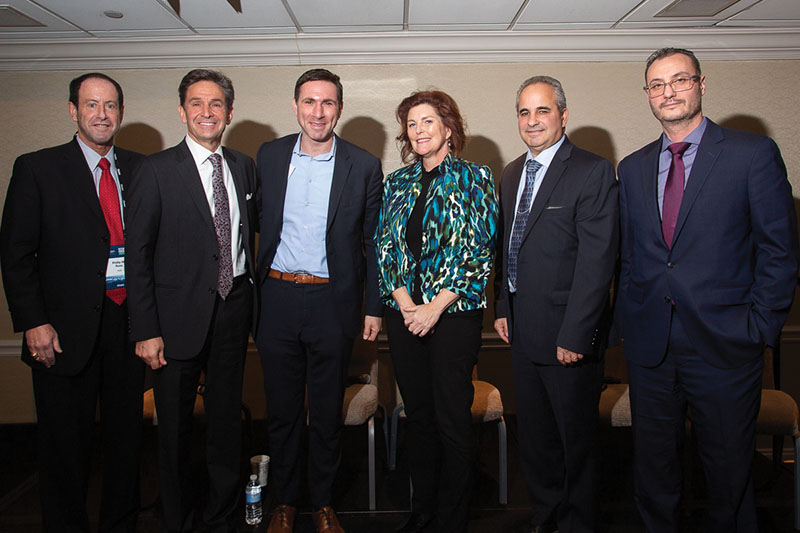
Manhattan, NY Anchin hosted its 6th annual industry-leading forum, Future Forward 2020: What’s Next for New York Real Estate and Construction, on February 4th at the Sheraton New York Times Sq. Hotel. The half-day conference brought together leading real estate owners and developers, construction executives and other key business decision-makers to discuss the transforming NYC market. Speakers covered topics such as New York’s burgeoning tech industry rivaling the Bay Area, creative solutions to New York’s new rent regulation laws, new development trends and the importance of project management services and M/WBE strategies, as well as the prospect of joint ventures between contractors, among many others.
The forum featured keynote speaker Peter Riguardi, chairman and president of Jones Lang LaSalle’s New York Tri-State Region, as well as panels of key players from across the industry. During his keynote, Riguardi explored how New York City’s exponential market growth can be attributed to low unemployment rates, the lowest in the city’s history, as well as an influx of technology-focused job opportunities. Banks are upgrading space to compete with the tech industry in the ongoing battle for talent, while tech companies are beginning to expand in other markets to support the cost of competition in NYC. This all presents opportunities for neighborhoods to thrive during this expansion.
Featured panels during the event included “Trends in Multifamily,” moderated by Marc Wieder, partner and co-leader, Anchin’s Real Estate Group; “New Development Trends,” moderated by Robert Gilman, partner and co-leader, Anchin’s Real Estate Group; “P3 Partnerships and Design Build,” moderated by Phillip Ross, partner and leader of Anchin’s Architecture and Engineering and Construction Industry Groups; “Project Management Strategies” breakout session led by David Horowitz, regional director, Colliers Project Leaders; and “M/WBE Issues in Construction” breakout session led by Charles Williams III, partner, Peckar & Abramson.
“New York is shifting markets and is quickly becoming the tech capital of the world,” said Riguardi. “Not only does this change mark a new prosperous future for New York, but it paints the city as the new long-term home for a diverse range of businesses.”
“Our speakers today have propelled our industry forward through creative strategies drawn from deep industry experience and knowledge,” said Phillip Ross, partner and leader of Anchin’s Architecture and Engineering and Construction Industry Groups. “They are redefining business in real estate and construction, creating new efficiencies and delivering on the project and end-user needs of the future. They have been major contributors to an industry that is more sustainable, more technology- and data-driven and more responsive to the market than ever before.”
The P3 Partnerships and Design Build panel brought together leaders from public agencies, contractors and design firms to discuss the intrinsic benefits of joint ventures as a result of adopting a design-build method on projects. Design-build presents the opportunity for all members of the project team to problem-solve and innovate throughout the project lifecycle. When dealing with these often large-scale projects, there are greater inherent risks and costs for construction firms, but design-build can also bring significant cost savings through more streamlined efficiency and process control. Design-build strategy brings an enhanced ability to coordinate with all parties in the planning process and better understanding of potential costs. Still, there are a limited number of contractors who can deliver on projects of this size, so P3 and design-build are creating opportunities for new contractors, particularly MWBE firms, to train and become upskilled to meet the demand for this growing trend. Overall, the panel stressed the importance of collaboration in P3 and design-build that draws on the collective strength of the firms involved.
Discussion during the Trends in Multifamily panel centered on the impact to market activity following the recent legislative overhaul to New York State laws related to rent-stabilized properties. Industry experts on the panel all acknowledged more must be done to improve quality and access to more affordable housing in New York, but also agreed new laws would deter renovations to aging inventory and devalue a wide range of real estate businesses active in the market. These New York State laws, along with the continued effect of State and Local Tax Deduction changes as part of 2017 federal tax reforms to the multifamily market, led panelists to discuss the increased migration of residents and real estate business activity to markets outside of the Northeast.
“Recent changes to State and Federal tax law have forced multifamily investors in New York City to reassess their business models, making this panel all the more important,” said Wieder. “Talking through creative solutions with such impactful industry leaders helped define a clear picture for the future of New York’s multifamily market.”
The New Development Trends panel explored several pressing topics for the national and regional industries, including the impact of rising land and construction costs to each panelists’ business and the outlook moving forward, as well as how the amenities race and tenant preference of more communal space in lieu of larger unit size has changed new development strategy. From coworking space, speakeasys and even dog spas, developers are following tenant trends more than ever. Panelists also debated if construction costs have peaked following the recent completion of several megaprojects and how to measure higher union labor costs against the value of projects potentially finishing more quickly and with higher quality.
“While still vibrant, the New York development market has come to an inflection point as several major development projects are now complete and rising construction and land prices return to the mean,” said Gilman. “To maximize return on investment through potentially volatile economic conditions, industry leaders are examining new approaches to ground-up development and acquisition strategy to meet changing consumer preferences and mitigate risk.”
The full agenda and speaker list at anchinfutureforward.com/home.
